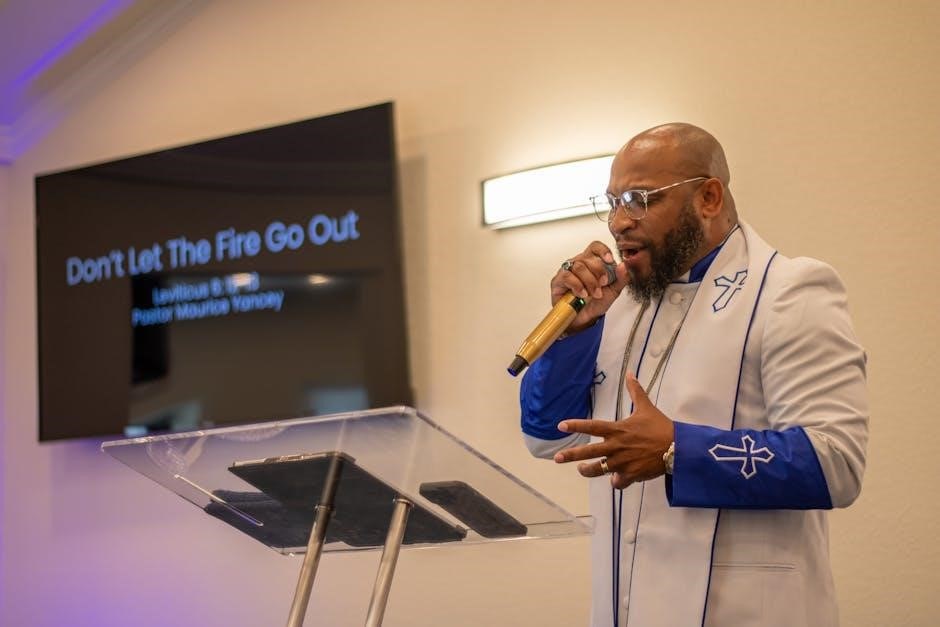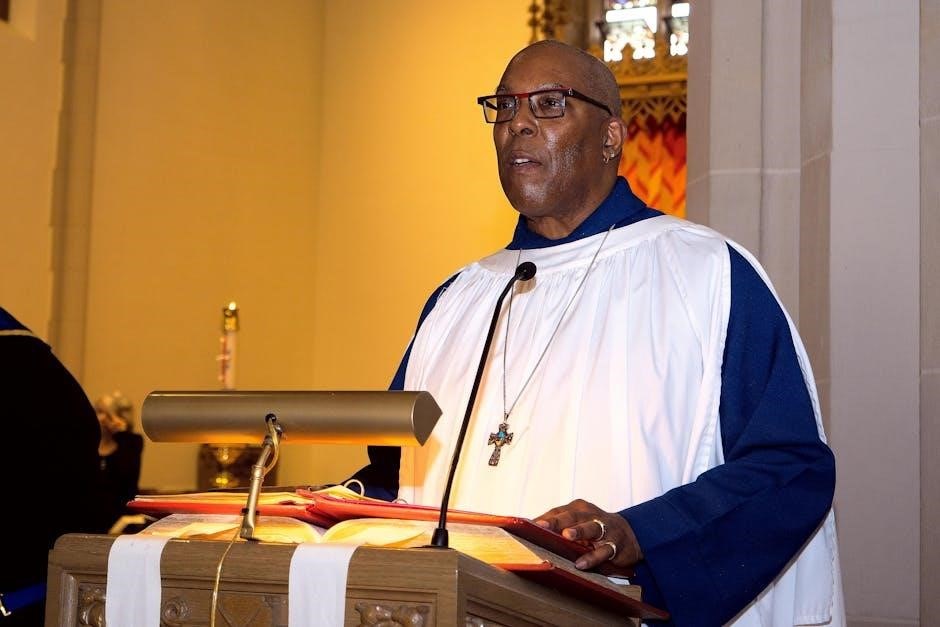Preachers play a vital role in spiritual leadership, guiding communities through scripture and inspiration. Their sermons, whether written or spoken, shape faith and foster growth. Effective preaching balances tradition with contemporary relevance, ensuring timeless truths resonate across generations.
1.1. The Role of Preachers in Religious Communities
Preachers serve as spiritual guides, providing inspiration, guidance, and biblical insights to their communities. Their role extends beyond delivering sermons, encompassing pastoral care, teaching, and fostering unity. Effective preachers adapt their message to meet the needs of their audience while remaining faithful to scripture, ensuring spiritual growth and communal strength.
1.2. The Evolution of Preaching Styles Over Time
Preaching styles have evolved significantly, adapting to cultural shifts and theological emphases. From the formal, doctrinal focus of earlier centuries to the personal, narrative approaches of today, preachers like Martyn Lloyd-Jones and Francis de Sales have influenced this transformation. The Reformation emphasized biblical exegesis, while modern preachers incorporate storytelling and technology, ensuring relevance without compromising sacred truths.
Key Elements of Effective Sermons
Effective sermons combine clarity, biblical grounding, personal testimony, storytelling, and practical application to engage and transform listeners, fostering spiritual growth and community connection meaningfully.
2.1. Biblical Exegesis and Its Importance
Biblical exegesis is the cornerstone of effective preaching, ensuring sermons are rooted in accurate, contextual understanding of Scripture. This method involves thorough analysis of the text, considering historical, cultural, and linguistic contexts to uncover its original meaning. By doing so, preachers provide congregations with a clear, authentic understanding of God’s Word, fostering spiritual growth and edification. This approach also helps preachers avoid misinterpretation, ensuring their messages remain faithful to the Bible’s teachings. Ultimately, exegesis bridges the gap between ancient texts and modern audiences, making the Word of God relevant and applicable to everyday life.
2.2. The Role of Personal Testimony in Preaching
Personal testimony adds authenticity and relatability to sermons, allowing preachers to connect with their audience on a deeper level. By sharing personal experiences of faith, struggles, and transformation, preachers illustrate how biblical truths apply in real life. This vulnerability fosters empathy and trust, making the message more impactful and memorable. Personal stories also humanize the preacher, emphasizing that spiritual growth is a shared journey rather than a distant ideal. This approach not only enriches the sermon but also encourages listeners to reflect on their own faith experiences, creating a more engaged and responsive congregation. It bridges the gap between doctrine and daily life.
2.3. Engaging the Audience Through Storytelling
Storytelling is a powerful tool in preaching, capturing attention and making sermons relatable. By sharing narratives, preachers create vivid imagery, evoke emotions, and convey complex truths in an accessible way. Stories bridge cultural and generational gaps, fostering connection and understanding. They also encourage listeners to reflect on their own experiences, making the message more personal and impactful. This approach ensures lasting engagement and memorable lessons.

Famous Preachers and Their Contributions
Renowned preachers like Martyn Lloyd-Jones and Francis de Sales have shaped preaching through their unique styles and deep theological insights, leaving a lasting impact on religious discourse.
3.1. Martyn Lloyd-Jones: A Giant of 20th-Century Preaching
Martyn Lloyd-Jones, a prominent 20th-century preacher, emphasized expository preaching and the importance of the Holy Spirit’s role in sermons. His teachings highlighted the need for preachers to balance intellectual rigor with spiritual passion, ensuring that sermons were both informative and transformative for the congregation. His legacy continues to inspire modern preachers in their approach to biblical exposition.
3.2. Francis de Sales: Insights on Preaching and the Preacher
Francis de Sales offered profound insights into the art of preaching, emphasizing the importance of a preacher’s personal holiness and compassion. He advocated for sermons that balanced theological depth with accessibility, ensuring messages resonated with diverse audiences. His writings stressed the preacher’s role as a spiritual guide, fostering faith and virtue through heartfelt, biblically grounded sermons.
3.3. Lloyd-Jones’ Emphasis on Expository Preaching
Martyn Lloyd-Jones championed expository preaching, believing it essential for uncovering biblical truths. He stressed the preacher’s role in meticulously unpacking scripture, ensuring sermons were both doctrinally sound and practically applicable. His approach emphasized the Holy Spirit’s power in illumination, making expository preaching a cornerstone of spiritual growth and authentic Christian living.

The Purpose and Impact of Preaching
Preaching aims to inspire spiritual growth, comfort believers, and strengthen the church. It fosters community, provides guidance, and deepens faith, empowering individuals to live according to God’s will.
4.1. Spiritual Growth and Edification of Believers
Effective sermons foster spiritual growth by guiding believers to apply biblical truths to their lives. Through expository preaching, listeners are edified, comforted, and equipped to walk faithfully. Martyn Lloyd-Jones emphasized that true preaching ignites a deeper love for God, encouraging personal reflection and prayer. This nurturing process strengthens believers, enabling them to live out their faith authentically and support one another in their spiritual journeys.
4.2. Preaching as a Tool for Community Building
Preaching serves as a powerful catalyst for building and strengthening communities. By addressing collective challenges and shared values, sermons foster unity and cooperation. Dynamic churches use missional preaching to equip believers for outreach, creating a sense of purpose and belonging. This communal focus ensures that preaching not only edifies individuals but also unites them in faith and action, transforming congregations into vibrant, mission-driven families.

Resources and Guides for Preachers
Recommended books include works by Martyn Lloyd-Jones and Francis de Sales, offering insights on effective preaching techniques. Online libraries and free PDF materials further support sermon preparation and delivery, providing accessible tools for preachers to refine their craft and engage audiences meaningfully.
5.1. Recommended Books on Preaching Techniques
Essential books like Preaching and Preachers by Martyn Lloyd-Jones and The Preacher and His Preaching by Francis de Sales offer timeless insights. These works emphasize biblical exegesis, personal testimony, and engaging storytelling. They provide practical guidance for sermon preparation and delivery, equipping preachers to communicate effectively and inspire spiritual growth in their audiences.
5.2. Online Libraries and Free PDF Materials
Online libraries like Project Gutenberg offer over 60,000 free eBooks, including works on preaching. PDF guides provide step-by-step sermon preparation and insights into expository preaching. Resources on Reformation-era sermons highlight their historical impact, while modern materials focus on engaging audiences and missional preaching, making them invaluable for preachers seeking diverse perspectives and practical tools for effective ministry.

The Role of Personality and Calling in Preaching
A preacher’s personality and divine calling significantly shape their effectiveness. Authenticity, passion, and a deep connection to their vocation foster meaningful engagement with the congregation, enhancing the spiritual impact.
6.1. The Preacher’s Personality and Its Influence
A preacher’s personality profoundly influences their ministry. Authenticity and empathy create connections, fostering trust and engagement. Passion and charisma can inspire, while humility and compassion build intimacy. The integration of personal traits with spiritual integrity enhances the preacher’s ability to convey divine truths effectively, making sermons relatable and impactful. This synergy between character and calling strengthens the congregation’s faith journey.
6.2. The Divine Calling: A Preacher’s Vocation

A preacher’s vocation is rooted in a divine calling, transcending personal ambition. This sacred summons compels them to fulfill God’s purpose, guiding others through scripture and spiritual truths. The calling demands dedication, sacrifice, and a deep commitment to serving others. It is a lifelong journey of faith, trust, and obedience, shaping both the preacher and their congregation in profound ways.
The Transition from Oral to Written Sermons
The shift from oral to written sermons enabled broader dissemination and lasting impact, preserving spiritual teachings for future generations and enhancing public engagement with religious messages.
7.1. The Impact of Written Sermons on Public Engagement
Written sermons have significantly enhanced public engagement by allowing widespread dissemination and accessibility. They provide audiences with the opportunity for personal reflection, deeper understanding, and shared discussion, fostering a stronger connection to the message and its application in daily life. This accessibility ensures that spiritual teachings reach beyond the physical boundaries of a congregation.
7.2. The Role of Sermons in the Reformation Era
Sermons played a pivotal role during the Reformation, serving as a primary medium for spreading theological ideas. Reformers like Martin Luther utilized written sermons to challenge traditional doctrines, fostering widespread theological debate. The transition from oral to written sermons enabled ideas to reach broader audiences, influencing public life and shaping the spiritual landscape of the era.

Modern Trends in Preaching
Modern preaching integrates technology, such as video streaming and interactive media, to enhance engagement. Missional preaching emphasizes contextual relevance, adapting messages to meet contemporary societal and cultural needs.
8.1. The Use of Technology in Contemporary Preaching

Technology has revolutionized preaching, enabling global reach through live streaming and online platforms. Digital tools like video sermons, social media, and sermon archives enhance accessibility. Preachers now utilize software for sermon preparation and multimedia presentations, blending tradition with innovation to engage modern audiences effectively.
8.2. Missional Preaching in a Dynamic Church Context
Missional preaching emphasizes aligning sermons with the church’s mission, fostering discipleship and community impact. In dynamic contexts, preachers adapt messages to cultural needs, encouraging believers to live out their faith actively. This approach ensures sermons are relevant, transformative, and outward-focused, equipping congregations to serve and influence their surroundings effectively.
The Pragmalinguistic Analysis of Church Preaching
Pragmalinguistic analysis examines how language functions in religious communication, focusing on sermon structures, rhetorical devices, and audience engagement within church settings.
9.1. Features of Church Preaching and Epitaphs
Church preaching often employs rhetorical devices, emotional appeals, and scriptural references to engage audiences. Epitaphs, while concise, similarly use brevity to convey profound truths, reflecting shared goals of inspiration and remembrance in religious communication.
9.2. The Role of Language in Religious Communication
Language in religious communication serves as a bridge between the divine and human understanding. It conveys sacred truths, evokes emotions, and fosters spiritual connection. Effective use of language ensures messages resonate deeply, guiding believers toward reflection, growth, and a closer relationship with their faith.
Preparing and Delivering Expository Sermons

Preparing and delivering expository sermons involves thorough biblical analysis, personal testimony, and clear structure to transform scripture into relatable, impactful messages for modern audiences.
10.1. A 10-Step Guide to Preparing a Sermon
Choose a passage, 2) gather commentaries and sermons, 3) study the context, 4) outline the message, 5) craft a clear thesis, 6) incorporate personal testimony, 7) engage with storytelling, 8) ensure practical application, 9) pray for clarity, and 10) review and refine the content for impactful delivery.
10.2. The Delivery of the Sermon: Practical Tips
Make eye contact with the congregation to build connection. Vary tone and pace for emphasis. Use gestures naturally to enhance expression. Practice beforehand to ensure confidence. Pause for reflection and engagement. Speak clearly, projecting your voice. Encourage participation through questions. Conclude with a strong, memorable closing. Pray before and after delivery for divine guidance.
The Legacy of Martyn Lloyd-Jones
Martyn Lloyd-Jones left an enduring impact on modern preaching through his expository style and emphasis on the preacher’s divine calling. His sermons and writings continue to inspire pastors globally, fostering a deeper understanding of scripture and its application.
11.1. His Vision for the Church and Preaching
Martyn Lloyd-Jones envisioned a church deeply rooted in the Gospel, prioritizing spiritual growth over formalism. He advocated for preaching that ignites passion for God’s Word, equipping believers to live missional lives. His emphasis on expository preaching and the preacher’s divine calling remains foundational, shaping modern church practices and inspiring leaders to uphold biblical integrity.

11.2. The Enduring Influence of His Sermons
Martyn Lloyd-Jones’ sermons continue to inspire globally, offering profound insights into Scripture. His expository style bridges historical context with modern relevance, making his teachings timeless. Available in print and digital formats, his work remains a cornerstone for preachers and believers, fostering spiritual depth and a steadfast commitment to Gospel-centric living across generations and cultures.
Effective preaching remains vital, blending tradition with modern tools to inspire spiritual growth. Its enduring relevance ensures continued impact in a dynamic, ever-changing world.
12.1. The Future of Preaching in a Changing World
The future of preaching lies in blending timeless truths with modern methods. Preachers must adapt to technological advancements, engaging audiences through digital platforms and social media. While the core message remains unchanged, the delivery must evolve to resonate with diverse cultures and generations. Embracing innovation while staying rooted in scripture will ensure preaching remains relevant and impactful in a dynamic world.
12.2. The Eternal Relevance of Effective Preaching
Effective preaching remains timeless, transcending cultural and generational boundaries. Its power lies in its ability to connect individuals to divine truths, fostering spiritual growth and comfort. Despite changing world dynamics, the core purpose of preaching—to inspire, guide, and transform—endures, making it an eternal pillar of religious communication and community building.